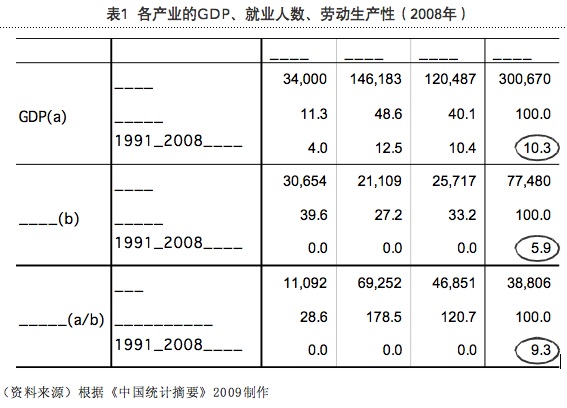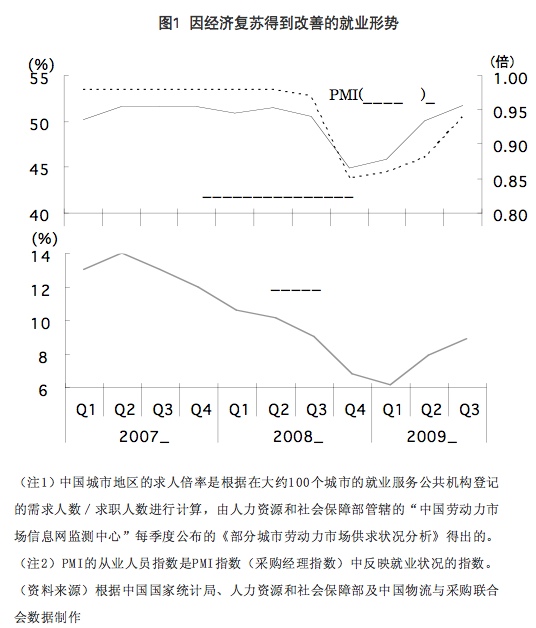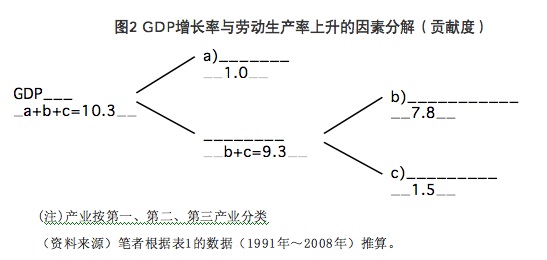(159)
Move over, it's my turn
KENTA SUJINO
THE ASAHI SHIMBUN
2009/12/29
 Move over, it's my turn (KENTA SUJINO/ THE ASAHI SHIMBUN)
Move over, it's my turn (KENTA SUJINO/ THE ASAHI SHIMBUN)
A Bengal tiger cub takes a swipe at a wide-eyed Jersey calf during a "changing of the guard" ceremony to mark the passage from the Year of the Ox to the Year of the Tiger at Tsutenkaku tower in Osaka's Naniwa Ward. In keeping with tradition, the humans at the event, now in its 54th year, used humor to coin one-liners that played on words associated with the two animals and poked fun at events of the past year while praying for better luck next year.(IHT/Asahi: December 29,2009)
(158)
从创造就业转向提高生产率
\ 日本野村资本市场研究所高级研究员 关志雄 为英国《金融时报》
中文网撰稿 2009-12-29
应该优先扩大就业还是提高生产率?
在中国,迄今由于农村地区有大量的过剩劳动力,因此对于政府来说,创造就业成为最重要的政策课题。然而,随着接近经济发展的充分就业阶段,劳动力供 给渐渐开始制约经济增长。要继续维持高速增长,必须把政策的重点从创造就业向提高生产率转移。这与中国政府要实现的从粗放型增长向集约型增长转变的方针也 是一致的。
从1991年至2008年,中国的GDP年平均增长率达到10.3%。与此相比,就业的年平均增长率只有1.0%(参见表1)。其中增长率高达 12.5%的第二产业(工业)的就业年增长率也只有2.4%。在中国,很多经济学家把高经济增长率与低就业增长共存的现状称为无就业增长,视为严重的问 题。政府也为了保证就业,长期优先发展劳动集约型产业。

但是,如果换个角度来看,就业年均增长率只有1.0%,GDP却增长了10.3%,这意味着劳动生产率的年均增长率达到9.3%,对经济增长做出了重大贡献。无就业增长&也可以看作是不依靠增加劳动力投入的增长(=依靠提高劳动生产率的增长)。
由此可见,如果把GDP增长率作为既有条件,那么劳动生产率和创造就业处于此消彼长的关系。应优先哪一方,根据劳动市场的供求状况可以做出不同的判 断。在劳动力剩余,失业者过多的前提下,即使牺牲劳动生产率,也必须创造就业机会。与此相反,当实现了充分就业时,为了保持高增长率必须维持劳动生产率的 高增长率。
接近刘易斯转折点
迄今为止,一般认为中国的农村地区存在大约1.5亿人的剩余劳动力。在中国政府编写的《国家人口发展战略研究报告》(2007年1月公布)中也援引 了同一数字。对于这种劳动力过剩说,中国社会科学院人口与劳动经济研究所所长蔡昉根据一系列的研究提出了异议,认为低生育率、老龄化以及大规模的人口流动 导致了农村地区过剩劳动力的枯竭。他进而又论证了意味着在经济发展中实现充分就业的刘易斯转折点将于2009年来临,引起了热议(中国经济面临的转折及其 对发展和改革的挑战《中国社会科学》,2007年第3期;《中国就业增长与结构变化》,中国社会科学院报告,2007年5月10日)。
其后,由于受到雷曼危机的影响,对劳动力的需求一时大幅度下滑,在城市地区,众多的民工失去了工作,不得不返回家乡。但是,2009年夏季以来,正 如城市地区的求人倍率和采购经理指数(PMI)的从业人员指标得到大幅度改善所显示的,在经济复苏的同时,对劳动力的需求再次紧俏起来(参见图1)。

今后,随着从劳动力过剩向不足急速转变,预计不仅就业整体的增长将进一步下降,而且劳动力从第一产业向其他产业移动的速度也将放慢,从而使迄今为止 的高经济增长率变得越来越难以维持(参看“支撑GDP增长率与劳动生产率上升的产业间劳动力移动”一节)。以此为契机,中国政府政策的优先次序也会从重视 就业转变为重视生产率。而且,一旦从必须创造大量就业机会这一制约中解放出来,中国将从劳动集约型产业“毕业”,以向附加值更高的领域转移资源的形式,加 速产业升级。最近,中国的劳动集约型产业陷入萎缩,而另一方面,汽车和钢铁等重工业实现了飞跃发展,就是这种征兆的表现。
支撑GDP增长率与劳动生产率上升的产业间劳动力移动
从供给方面来看,GDP增长率作为衡量产业整体生产增长的指标,反映着就业量的增加(劳动力投入)与劳动生产率的增长。后者不仅受各产业的劳动生产率增长的影响,而且还受到产业间劳动力移动的影响。
在中国,各产业的劳动生产率,无论从水平上看,还是从增长率上看,都是第二产业最高,接下来是按第三产业和第一产业的顺序下降(参见表1)。不仅各产业的劳动生产率上升,劳动力从第一产业向第二产业和第三产业的移动也提高了整体的劳动生产率。
实际上,如果以1991年至2008年的数据为对象,把GDP增长率分解为“就业人数的扩大”和“劳动生产率的上升”,并把劳动生产率的上升分解为 各产业劳动生产率的上升”和“产业间劳动力移动”等因素,就可以推算出,在GDP增长率(10.3%)中,就业人数的扩大和劳动生产率的上升所实现的贡献 度分别为1.0%和9.3%,而在劳动生产率的上升中,各产业的劳动生产率的上升和产业间的劳动力移动所实现的贡献度分别为7.8%和1.5%(参见图 2)。
同志社大學
我再台大文學院拿到一本 "鼓動"--同志社大學130年紀念冊 有點意思(156)
中國選什麼台灣最熱門的政治人物
其中竟然有低胸"原住民"裝的高金素梅--砸下億元的表演
(155)
讀到某報說明中國大學生失業問題嚴重 所以將一些科系分類為 紅 黃 綠
還說什麼需要建立預警制等等胡說
)154(
這是很奇怪的分析 只算表面的錢
其實叫車的 主要目的不是省錢
手機叫車 未必省荷包 工商時報 2009-12-29
【馬婉珍/台北報導】 計程車隊業者競爭激烈,大打價格割喉戰,甚至提供手機撥打5碼簡碼即可叫車的服務,並搭配折扣優惠吸引消費者,但消基會提醒,手機簡碼叫車未必划算,以下3大要項應注意: 一、線上等候派車的時間,由消費者負擔:消基會副秘書長黃鈺生指出,多數計程車隊業者強打「手機叫車優惠多」的好康,但消費者於線上等候派車的時間,有些業者並未代為負擔,並非物美價廉,甚至可能比路邊攔車更貴。 以消基會的實際操作可見,從來電叫車到派車成功,約耗時150秒、也就是2分半的時間,以目前每秒0.1元至0.12元的費率計算,等待派車完成,消費者必須支付通話費15元至18元不等。 目前像是台灣大車隊、志英、泛亞等計程車隊業者,皆於消費者撥通後,主動告知費率且主動告知的10秒語音時間免費、由業者負擔費率。 二、「滿百7折」優惠,是指滿1百元以上的車資部份,才可以享7折折扣:消基會觀察,不論是「全日滿百以上7折」、「加入會員全日叫車7折」等優惠,幾乎都是超過100元車資部份才打折,而非以跳表金額直接折扣。 不過,像是友好、蓮花及台北衛星等計程車隊,皆提供最實在的回饋,也就是按跳表金額直接折扣,友好是跳表金額直接打8折,而蓮花則是日間坐車的車資滿150元後,一律可享8折折扣。 三、主動詢問優惠,選擇有利服務:黃鈺生指出,業者提供的優惠活動多半是文字遊戲,實際上未必划算,因此消費者應主動詢問業者,相關費用的折扣或收取方式,才能真正達到省荷包的目的。
(153)
"海爾要像《紅樓夢》裡寶釵那句話一樣:韶華休笑本無根,好風憑借力,送我上青雲。(王曉玟整理)"
自古標點是大問題 似乎應該這樣:
海爾要像《紅樓夢》裡寶釵那句話一樣:韶華休笑,本無根,好風憑借力,送我上青雲。
(152)
市面上的企管書充斥類似的神話:
賈伯斯把挫折當作試煉,每一次落入敗部正好考驗自己對於人生的熱情是否仍舊燃燒。本週超能力學堂,整理賈伯斯的3堂敗部學,想成功,得先學會如何失敗!
敗部學第1課:當對日常生活失去熱情時,要勇敢的放棄框架。
敗部學第2課:被自己創辦的公司開除,是人生當中很苦、但是必要的一帖良藥。
敗部學第3課:不要讓他人的噪音壓過自己的心聲。
(151)
MODERNISM:The Lure of Heresy From Baudelaire to Beckett and Beyond.
我希望以後之讀書會有報告 (如我們去年談漢寶德)--有的會收入我每年出的新書
......所以我會此小而精之方式
(150)
In 1988, Peter Gay was honored by The New York Public Library as a Library Lion.
****
A New Look for the Public Library’s Lion Logo
By JENNIFER 8. LEE New York Public Library Sketches that were drawn by New York Public Library staff members in the process of designing a new lion logo.
New York Public Library Sketches that were drawn by New York Public Library staff members in the process of designing a new lion logo.The library lion has shed its shaggy mane for the digital age.
For the first time in at least a quarter century, the New York Public Library has unveiled a new logo, this one designed to work both online and in print. Consisting of a profile of a lion inside a circle, it sheds the fussy detail of the old one. Instead, it uses bold, simple lines that evoke the style of stained-glass windows, woodcuts, or old printers’ marks.
 New York Public Library The old logo of the New York Public Library would lose detail when it was too small.
New York Public Library The old logo of the New York Public Library would lose detail when it was too small. New York Public Library The library’s new lion logo.
New York Public Library The library’s new lion logo. The strong lines allow for the logo to be scaled to different sizes — a requirement in an age when people are as likely, if not more likely, to see a logo on their computer as they are in print. “It’s got to be able to work that small and that large,” explained Marc Blaustein, art director for the library system, who oversaw the creation of the logo. The old logo had a hard time maintaining its detail as it shrank, Mr. Blaustein said.
At the same time a logo can’t be overly simple. “If it gets too minimal, then it doesn’t have any energy,” said Brian Collins, a designer who has been involved with a number of logo redesigns, including one for Yahoo.
The new logo has already been introduced on the library Web site and will be adopted eventually on library signs, library cards, and printed materials. (One hopes it will have a more positive response than the New York City taxi logo.)
The library started considering a redesign more than a year ago, in large part because it wanted to convey a more modern and digital-friendly image. The process also included adoption of a new color palette and a new typeface. Instead of going to an outside agency, the task fell to the library’s own staff. “This is an in-house product,” said Paul LeClerc, president of the library.
The logo started with a lion — specifically, Fortitude, the northern of the two lions that flank the steps to the main library, also known as the Stephen A. Schwarzman Building. The other lion is Patience.
(”It’s primarily based on Fortitude, but it’s a combination of both,” said Mr. Blaustein. “The angle is Fortitude, but some of the features are inspired by Patience.”)
While the lion had to be the focus, the conceptualization of the design was left open. “We explored dozens of concepts and did hundreds of drawings,” Mr. Blaustein said.
After searching through hundreds of typefaces, the staff settled on a sans-serif typeface called Kievit, which was designed by Michael Abbink in 2001. It was chosen in large part because it was contemporary and worked well on the Web and in print.
In contrast, there are fonts, such as Microsoft’s Verdana, that are designed to be screen-friendly. But the migration of some of these fonts into print, as in the case of the Ikea catalog, can be very controversial among typeface aficionados.
One enduring mystery: the origins of the old logo and its age. Mr. Blaustein said his search had turned up little about its history. “No one knows who designed it,” he said. Libraries excel at preserving history, but not always, it seems, their own.
沒有留言:
張貼留言